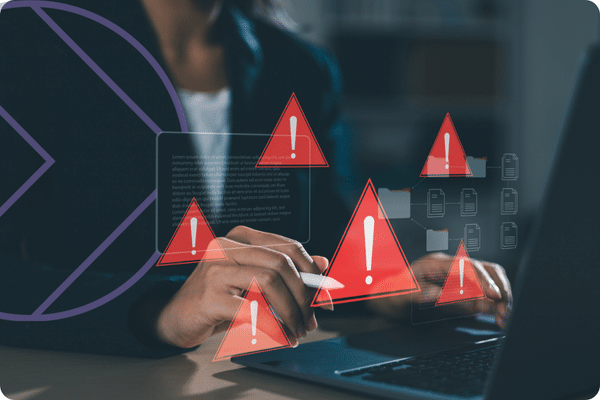Phishing remains one of the most significant cyber threats to businesses worldwide. According to the Acronis Cyberthreats Report for the second half of 2024, phishing accounted for 74% of all attack vectors, making it the most common method used by cybercriminals. By exploiting targeted manipulation techniques, attackers aim to steal sensitive data, inflict financial damage, or gain unauthorized access to corporate networks. In this article, we explore how employee training and advanced security technologies can help detect and mitigate these threats.
Phishing – An Underestimated Threat
Phishing is a sophisticated form of digital fraud in which cybercriminals use fake emails, websites, or social media messages to steal sensitive information such as passwords, credit card details, or corporate access credentials. They deliberately pose as trusted institutions, business partners, or employees to deceive their victims into disclosing confidential data.
In addition to traditional phishing emails, other attack methods have become prevalent: Smishing (SMS phishing) uses text messages to lure recipients onto fraudulent websites, while Vishing (voice phishing) employs deceptive phone calls to extract sensitive information. Particularly insidious is Business Email Compromise (BEC), where attackers infiltrate legitimate corporate communication to redirect payments or compromise internal systems. Moreover, Angler phishing is becoming increasingly popular on social media—here, criminals disguise themselves as support staff to steal user data.
While spam primarily consists of unwanted advertising, phishing has a criminal intent: the targeted theft of identities, login credentials, or financial resources. These attacks range from simple scam emails to highly sophisticated deception tactics leveraging deepfake technologies. Given the constantly growing threat landscape, a comprehensive security strategy is essential to detect and effectively combat phishing attacks at an early stage.
Identifying Phishing Attacks
Phishing tactics are becoming increasingly sophisticated. In the past, obvious grammar mistakes or unprofessional wording served as warning signs. Today, however, AI-enhanced attacks make phishing attempts harder to spot. Nonetheless, several indicators can help detect fraudulent activity:
- Unusual sender addresses: Phishing domains often closely resemble legitimate corporate addresses. For example, an attacker might use “support@paypa1.com” instead of “support@paypal.com” to build false trust.
- Urgency tactics: Phrases such as “Immediate action required” create pressure, leading victims to act hastily—whether by entering credentials or opening malicious attachments.
- Fake links and attachments: Before clicking a link, hover over it to reveal the actual URL. Fraudulent links often differ from their displayed addresses and lead to phishing sites.
- Unusual communication patterns: Sudden changes in tone or language can be suspicious. If a supervisor unexpectedly requests a confidential financial transfer via email or a colleague writes in an uncharacteristic style, it may indicate deception.
Creative Deception: Phishing Becomes More Sophisticated
Some phishing emails incorporate creative but suspicious elements. Fake emails may simulate authentic conversation threads to create the illusion of legitimate correspondence.
Additionally, “deepfake phishing”—where AI-generated voices or videos impersonate executives or business partners—is on the rise. Poorly translated phrases such as “For your protection, we have hung up your credit card” or unprofessional wording like “Açtion Required” can also be red flags. Attackers frequently use emotional manipulation, leveraging fear or curiosity to prompt impulsive actions from victims.
Technological Measures Against Phishing
Beyond awareness training, technological solutions play a crucial role in phishing defense. Companies should implement a combination of security mechanisms, including:
- Email authentication: Technologies like DMARC, SPF, and DKIM prevent cybercriminals from sending emails on behalf of a company. These protocols validate the authenticity of senders by ensuring emails originate from authorized sources.
- DNS security: DNSSEC prevents attackers from tampering with DNS records and ensures users are not redirected to fraudulent phishing sites instead of legitimate ones.
- Two-factor authentication (2FA): Even if login credentials are stolen, 2FA prevents unauthorized access. This measure significantly reduces the risk of account takeovers, especially for cloud services and VPNs.
- AI-powered threat detection: Artificial intelligence analyzes email patterns and filters suspicious messages. Modern systems leverage machine learning to automatically detect fraudulent content, communication anomalies, and malicious attachments.
Employee Training as the First Line of Defense
Technical solutions alone are not enough—employees remain the last line of defense against phishing attacks. Therefore, regular training is essential to reinforce cybersecurity awareness within organizations:
- Phishing simulations: Simulated attacks help identify vulnerabilities by assessing how many employees fall for phishing emails. These tests enable companies to tailor training for at-risk user groups.
- Interactive training: Hands-on training teaches employees how to recognize and respond to phishing attempts effectively. The most effective programs use real-life scenarios and gamification elements to enhance engagement and retention.
- Clear reporting channels: Companies should establish defined procedures for reporting suspicious emails to the IT security team. A centralized reporting tool or a “Report Phishing” button in email applications makes it easier for employees to flag potential threats.
Comprehensive Phishing Protection
With CONVOTIS’ security awareness program, companies can strengthen their cyber defense sustainably. Cybercriminals rely on psychological manipulation to trick employees into disclosing sensitive data. Therefore, fostering continuous security awareness and action-oriented training is critical.
Through interactive learning, simulated attack scenarios, and regular assessments, teams can detect threats early and respond appropriately. A corporate culture that emphasizes education over fear fosters effective security awareness and significantly reduces vulnerability to cyberattacks.
Protect your business with targeted security awareness. Contact us today and enhance your cyber resilience.
